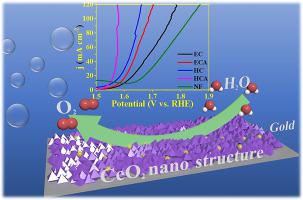Surfaces and Interfaces ( IF 5.7 ) Pub Date : 2023-07-20 , DOI: 10.1016/j.surfin.2023.103206 Soojin Park , Que T. Nguyen , Jeongsik Choi , Jong Hyun Park , Jae Ryang Park , Umesh T. Nakate , Sungjune Park

|
Water splitting is a promising method for producing pure hydrogen and oxygen electrochemically. However, the sluggish kinetics of the oxygen evolution reaction (OER) at the anode of a water splitting system reduces the efficiency of the reaction. To address this issue, various electrocatalysts have been developed for use in the OER. Among them, transition-metal-based materials (TMBMs) have emerged as promising candidates owing to their abundance, low cost, high redox states, and synergistic effects. The catalytic performance of TMBMs can be further enhanced by incorporating small amounts of noble metals. Based on this underlying principle, we developed trace amounts of gold nanoparticles (AuNPs)-decorated cerium oxide (CeO2) nanostructured electrocatalyst for a highly efficient OER. Previously, these composite materials have been utilized for this purpose; however, our approach is simple and facile: we incorporate noble metal elements on nanostructured catalysts synthesized by hydrothermal synthesis or electrodeposition. Metal salt aqueous solution-based alkali-free two different routes (hydrothermal synthesis or electrodeposition) were used for the direct growth of nanostructured CeO2 on nickel foam, followed by surface modification via the incorporation of gold using a simple wet impregnation method. The hydrothermally synthesized CeO2 electrode showed higher OER performance than the electrodeposited CeO2 electrodes. In both CeO2 nanostructures, AuNPs-decorated on the surfaces exhibited improved OER performance. Among the electrodes synthesized in this work, the hydrothermally synthesized AuNPs-decorated CeO2 nanostructures (termed HCA herein) exhibited a low overpotential 0.31 V at a current density of 10 mA cm−2, a low Tafel slope (30.25 mV dec−1), and a performance retention of 97% after 50 h, indicating excellent and stable OER performance. Hence, this approach for the synthesis of nanostructured composites can be used to produce other effective electrocatalysts for OER applications.
中文翻译:

直接生长湿法浸渍法合成金纳米粒子修饰的CeO2电催化剂用于增强析氧反应
水分解是一种很有前景的电化学生产纯氢和纯氧的方法。然而,水分解系统阳极的析氧反应 (OER) 动力学缓慢,降低了反应效率。为了解决这个问题,人们开发了多种用于 OER 的电催化剂。其中,过渡金属基材料(TMBM)因其丰富、低成本、高氧化还原态和协同效应而成为有前景的候选材料。通过掺入少量贵金属可以进一步增强TMBM的催化性能。基于这一基本原理,我们开发了微量金纳米颗粒 (AuNPs) 修饰的氧化铈 (CeO2)用于高效 OER 的纳米结构电催化剂。此前,这些复合材料已用于此目的;然而,我们的方法简单易行:我们将贵金属元素掺入通过水热合成或电沉积合成的纳米结构催化剂上。基于金属盐水溶液的无碱两种不同途径(水热合成或电沉积)用于在泡沫镍上直接生长纳米结构CeO 2,然后使用简单的湿浸渍方法通过掺入金进行表面改性。水热合成CeO 2电极比电沉积CeO 2电极表现出更高的OER性能。在CeO 2纳米结构,表面修饰的 AuNPs 表现出改善的 OER 性能。在本工作中合成的电极中,水热合成的AuNPs装饰的CeO 2纳米结构(本文称为HCA)在10 mA cm -2的电流密度下表现出0.31 V的低过电势、低塔菲尔斜率(30.25 mV dec -1) ,50小时后性能保持率为97%,表明OER性能优异且稳定。因此,这种合成纳米结构复合材料的方法可用于生产其他有效的 OER 应用电催化剂。













































 京公网安备 11010802027423号
京公网安备 11010802027423号